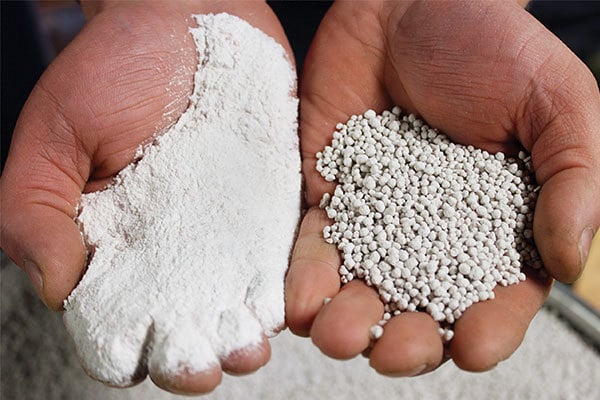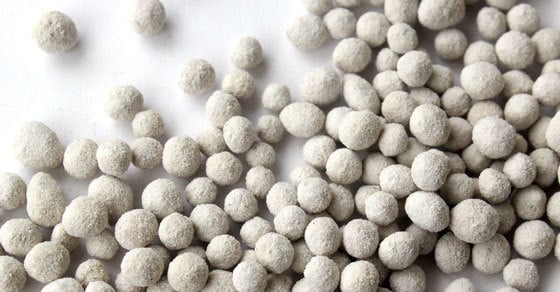When producers choose to agglomerate powdered bulk solids, they can gain a number of benefits, many of which contribute to improved economics of the operation as a whole – from a cleaner production environment, to improved product performance, and more. One often-forgotten aspect of managing bulk solids where agglomeration can deliver significant value is in dry bulk shipping.
While each material is different, many producers can expect the following dry bulk shipping benefits from agglomerating their material.
Greater Freight Density
One of the primary advantages to agglomerating bulk solids for shipment is that producers can achieve a greater freight density.
Freight density is the weight of a shipment in relation to its size. By maximizing freight density, producers are able to fit more product into the same size container, ultimately making shipping logistics more efficient. This often translates into fewer shipments, or fewer freight units per shipment, reducing transportation costs and lowering the company’s carbon footprint.
Agglomeration facilitates this by increasing particle density. Materials processed via spray drying, for example, are often light and aerated, occupying significantly more space than is necessary. By agglomerating these particles, their density is increased and the same amount of material takes up significantly less space, allowing more material to be packed into the same container. For the same reasons, agglomeration can offer the same benefits in regard to packing density.
While bulk density is highly material dependent, in many cases the flexibility of the agglomeration process makes it possible to achieve a target bulk density, putting more control into the hands of the producer.

Potash before (left) and after (right) agglomeration
Improved Flowability
Another major reason for agglomerating bulk solids prior to shipment is for improved flowability.
Powdered materials and fines can present significant flowability challenges during shipping and handling, whether being transferred from hopper to freight car, conveyor to cargo hold, or otherwise.
Poor flowability can result in a number of different problems, including reduced efficiency, loss of product, increased downtime for cleaning and maintenance, and even liability risks.
While many factors contribute to the flowability of a given material, in general, flowability is improved by increasing particle size. By agglomerating material, or rather increasing its particle size, flowability is greatly improved throughout the shipping and handling process. Some facilities may even require material to have a certain level of flowability in order to keep the operation running smoothly. Self-unloading ships, for example, rely on a material’s flowability to facilitate smooth unloading of the cargo.
Round granules such as those produced via the pelletizing process are recognized as being especially flowable, as they inherently allow less contact between particles, avoiding the interlocking of particles that can occur with granules produced via compaction granulation.
Reduced Product Loss
One especially frustrating aspect of dry bulk shipping minimized through agglomeration is product loss. While product loss can never be completely mitigated, agglomeration provides a tool to substantially reduce its occurrence, because agglomerates are much less prone to the ways in which product is typically lost:
Material Becoming Airborne
During the shipping process, material in the form of fines is highly susceptible to becoming windblown or otherwise aerated and dispersed into the surrounding environment. This may be alleviated to an extent by implementing measures such as gallery conveyor enclosures, minimized transfer points, and other tailored handling efforts, but will almost never be completely preventable.
By converting the fines into agglomerates, however, this issue is largely mitigated, because the density of the material is greater, making it less susceptible to being picked up or becoming airborne.
Material Loss Due to Caking
Finely divided solids and powders are much more prone to caking problems. Caking, or the undesirable clumping of material into large masses, can result in significant material spoilage and loss, or otherwise require reprocessing, increasing operational costs. It can also change the chemical and physical composition of the material, throwing off carefully engineered formulas.
Caking generally occurs as a result of the increased surface area contact between particles paired with the presence or absorption of moisture.
By agglomerating the material, the potential for caking is reduced by minimizing the amount of surface contact between particles (particularly when granules are round), and ensuring a stable product.
It should be noted that while substantially reduced, the potential for caking still exists even when materials are agglomerated. However, the agglomeration process also opens the door to coating granules with an anti-caking agent. Further measures may be necessary in cases where materials are notably hygroscopic, such as potash.
Decreased Surface Area Exposed to Air
Another key benefit of agglomerating bulk solids for shipment is the ability to reduce the amount of material surface area exposed to the air.
The amount of surface area exposed to air correlates with how much moisture a given material will absorb from its surrounding environment. Since fines have more exposed surface area, they have a greater potential for absorbing moisture from the air, particularly in the case of hygroscopic materials such as polymers, salts, and iron ores, and especially if the material will be shipped via ocean liner.
Moisture absorption has a number of potential consequences. First and foremost, it means the product is arriving to the customer in a different state than expected. This may mean reduced product performance, handling challenges, and more.
Further, as moisture absorption increases the potential for caking, material spoilage due to caking is more likely. In any case, moisture absorption often translates to a lower product value or a refusal to accept the product by the customer.
Agglomerating these fines reduces the amount of exposed surface area, ultimately reducing the potential for moisture absorption.
Segregation Prevention
Segregation occurs when disparate particles that were homogeneously mixed segregate back into a non-homogeneous mixture. Segregation typically occurs as a result of variation in particle size and density; a homogeneous mixture made up of varying particles, when agitated, will result in like particles migrating together, de-mixing the blend. Segregation can affect end product quality, downstream processing, and increase costs related to reprocessing.
By agglomerating such materials, however, segregation is prevented. This is because the disparate components can be thoroughly mixed into a homogeneous mixture and then agglomerated into uniform granules. Because the granules are uniform in size and density, and because each contains the full mixture of components, the potential for segregation is mitigated and the shipment arrives at its destination in the form (and formulation) intended.
Best Agglomeration Equipment for Dry Bulk Shipping
The agglomeration equipment or process configuration selected is dependent on the unique characteristics of the material, as well as the end product goals.
For example, if product density is a priority, a pin mixer may be selected for its ability to produce especially dense agglomerates from powders and fines.
If achieving a high level of particles within a narrow size distribution is important, a disc pelletizer (pan granulator) or pin mixer-disc pelletizer combination is likely to be the chosen technique (this approach is often referred to as pelletizing).
Or, if the goal is to de-dust/condition material in a high-capacity setting, a granulation drum or pugmill mixer may offer the best option.
The most appropriate technique may be determined as a result of expertise, or through agglomeration testing, such as that carried out in the FEECO Innovation Center. Testing is often important, however, as all materials respond differently to agglomeration.
Conclusion
Agglomeration can lend a host of benefits to dry bulk shipping, including greater freight density, improved flowability, reduced product loss, and more. For these reasons, many producers working with bulk solids choose to agglomerate their material as a way to improve the economics and efficiency of their operation.
FEECO is the leading provider of agitation agglomeration (also known as wet granulation) equipment and systems. In business since 1951, we’ve helped hundreds of customers overcome challenges in processing and handling bulk solids. For more information on our custom agglomeration equipment, testing services, or parts and service support, contact us today!

